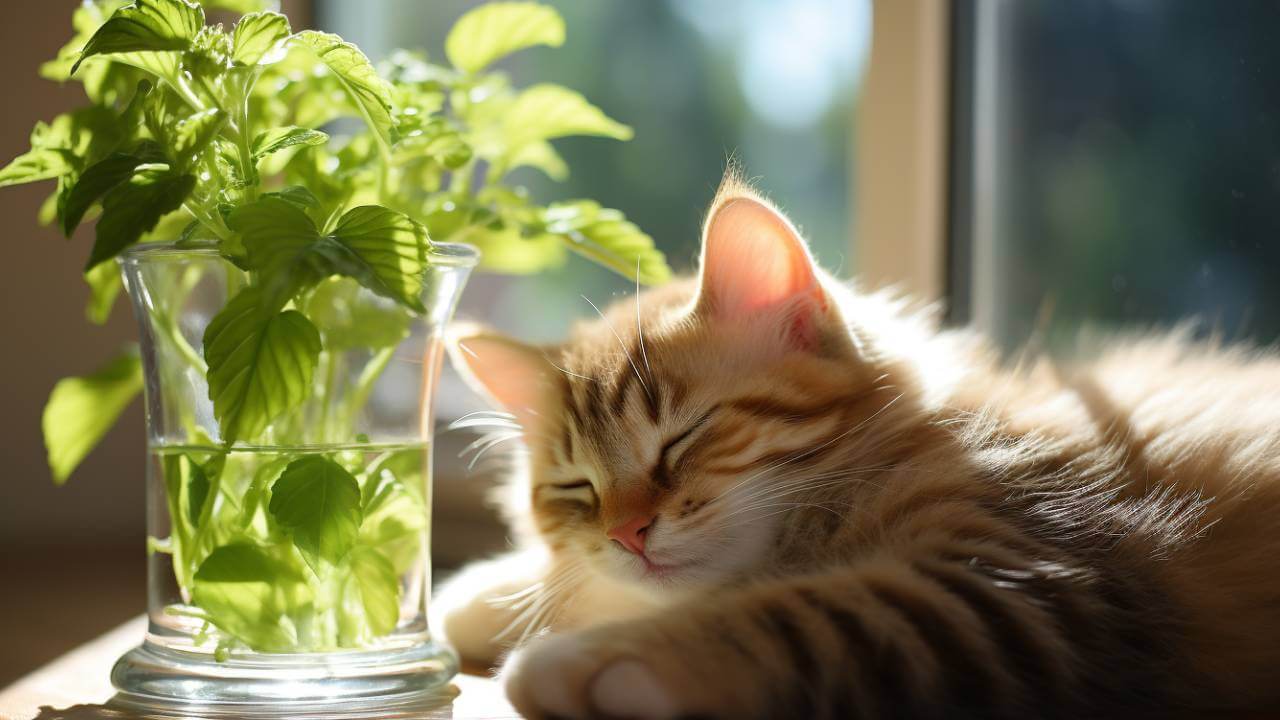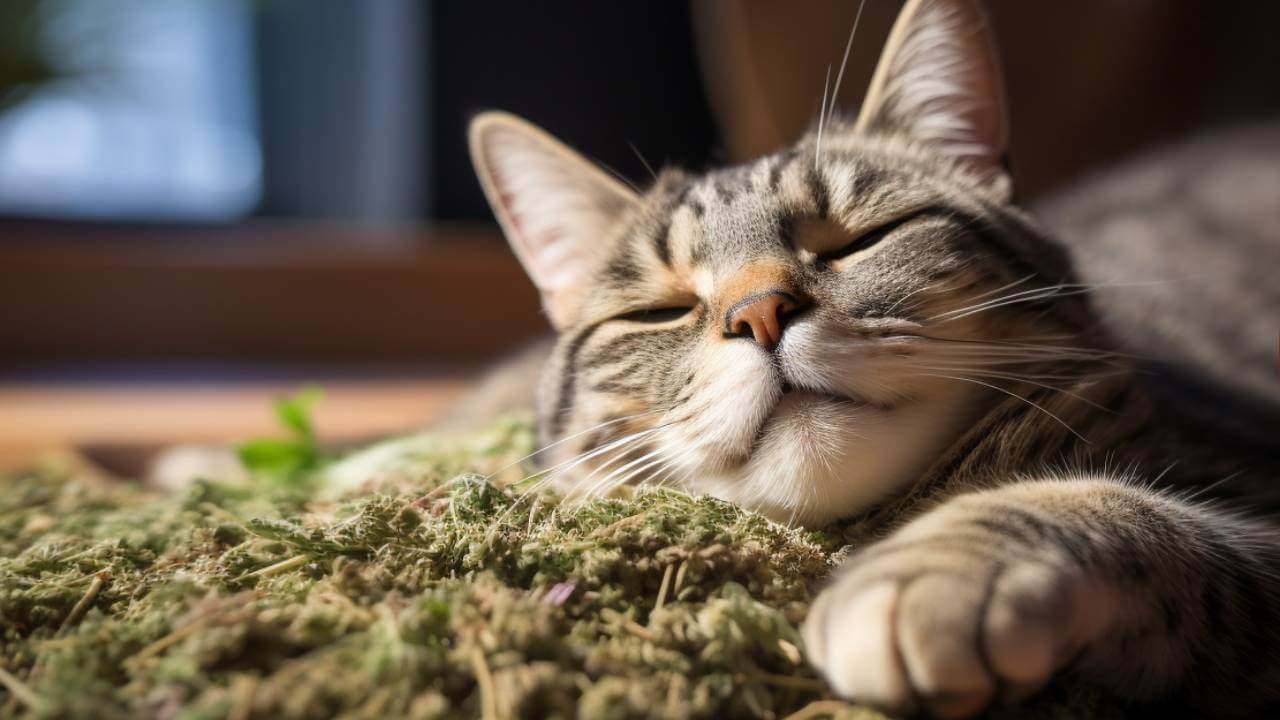Catnip, scientifically known as Nepeta cataria, is a herb beloved by many cat owners. Native to Europe and Asia, it’s now grown worldwide. This mint family member emits a unique aroma that captivates cats.
Cats encountering catnip often exhibit entertaining behaviors like rolling, rubbing, purring, and playful bursts. Not all cats are affected, as sensitivity to nepetalactone is hereditary; some may not respond.
How Does Catnip Work?
The secret behind catnip’s enchantment lies in its chemical composition. Catnip contains nepetalactone, which triggers a euphoric reaction in susceptible cats. When cats come into contact with catnip, whether by sniffing, licking, or even rubbing against it, they often exhibit playful behaviors.
Nepetalactone – a volatile compound in the catnip plant’s leaves, stems, and seeds. When these plant parts are crushed or disturbed, they release nepetalactone into the air, creating an irresistible aromatic experience for cats.
This compound interacts with a cat’s olfactory receptors, specifically those related to pheromones and sexual behavior. The response to nepetalactone is often one of excitement and playfulness.
Not all cats are affected by catnip, as the sensitivity to nepetalactone is inherited. Around 50-70% of cats are estimated to carry the gene that makes them susceptible to the effects of catnip.
Kittens and elderly cats are less likely to respond, with the sensitivity usually emerging around three to six months.
Is Catnip Safe?
For the majority of cats, catnip is a harmless and enjoyable indulgence. Here are a few key points to consider about catnip’s safety for your feline companion:
1. Natural and non-toxic 🌿 Catnip is a natural herb and is non-toxic to cats. It’s a safe way to provide mental and physical stimulation for your pet.
2. Short-lived effects ⏳ The effects of catnip are temporary and typically last about 10 to 15 minutes. The results will wear off quickly, even if your cat gets overly excited.
3. Non-addictive 🚫 Catnip is not addictive for cats. After the initial excitement, cats will return to their normal state without any lasting changes in behavior.
4. Variability 🐱 Cats’ reactions to catnip can vary widely. Some may become playful and active, while others may become calmer and relaxed. It’s essential to observe how your specific cat responds to catnip.
5. Safe for kittens and seniors 🐾 While kittens might not show much interest in catnip until they’re a few months old, and elderly cats might become less responsive, catnip is generally safe for cats of all ages.
Considering adding a new furry friend to your family? Check out our kittens for sale ready for adoption from verified breeders across the globe.
6. No long-term health risks: No known long-term health risks are associated with occasional catnip exposure. However, moderation is vital to preventing overstimulation. To ensure your cat’s health and safety in all aspects, consider exploring our cat insurance options
Remember, as with any treat or toy, moderation is essential. Offering catnip occasionally, once or twice a week, will keep your cat’s experience fresh and exciting.
How to Use Catnip?
You can offer catnip to your cat in various forms, such as dried leaves. Sprinkle a small amount on a scratching post or cat tunnels, or place it inside a cat toy.
Observe your cat’s reaction, but remember to use it in moderation to prevent overstimulation or diminished effects. Experiment with different catnip products to see what your cat prefers, and enjoy watching their playful and entertaining responses.

Experiment with different catnip products to see what your cat prefers, and enjoy watching their playful and entertaining responses through the best cat cameras.
A Catnip Overdose?
While catnip is generally safe and enjoyable, it’s essential to exercise caution and prevent your furry friend from indulging excessively. Here are four critical points to know about the possibility of a catnip overdose:
- Diminished effects: Offering catnip too frequently can lead to diminished effects over time. If exposed too often, cats might become less responsive or utterly immune to its allure.
- Potential overstimulation: Like anything enjoyable, too much of a good thing can be counterproductive. Excessive catnip can overstimulate your cat, causing restlessness, hyperactivity, or aggressive behavior.
- Digestive discomfort: In some cases, an overdose of catnip might lead to digestive discomfort. If cats consume a large quantity of catnip, they might vomit or experience an upset stomach.
- Temporary behavioral changes: While catnip’s effects are temporary, a catnip overdose might lead to quick behavioral changes that are not typical for your cat. These could include extreme hyperactivity or lethargy.
By being mindful of your cat’s reactions and practicing moderation, you can provide a safe and enjoyable catnip experience that adds a touch of excitement to their day without crossing the line into an overdose scenario.
Catnip, the best natural toy for cats, brings joy and fun into their lives. For the cat owner, watching the antics of their furry companion during a catnip session is enjoyable and entertaining.

FAQs
What is the origin of the name “catnip”?
The name “catnip” derives from the intense attraction most cats have towards the plant. Historically, “nip” comes from an older term used to describe a family of intense-smelling herbs. The combination reflects the unique relationship between the herb and feline behavior.
Can catnip be used for other purposes?
Yes, beyond its effects on cats, catnip has been traditionally used in herbal medicine by humans for its mild sedative effects. It is sometimes brewed into a tea to alleviate symptoms of insomnia, anxiety, and headaches. Additionally, catnip can serve as a natural insect repellent.
Why doesn’t it affect all cats the same way?
The response to catnip is genetic, and not all cats have the gene that triggers sensitivity to nepetalactone. This hereditary trait varies significantly among cats, explaining why some are indifferent to catnip while others are highly responsive.
Is it possible for cats to get too accustomed to catnip?
Cats can become habituated to catnip if exposed too frequently, which may reduce its effectiveness. To keep catnip responses fresh and exciting, limit exposure to once or twice a week and alternate it with other types of play or new toys.
Are there different types of catnips, and do they vary in potency?
Several species within the Nepeta genus are referred to as catnip, but Nepeta cataria is the most common. Potency also varies based on the plant’s growing conditions and harvest time. Some catnip products might also blend different parts of the plant or include leaves from related species to alter potency or effects.
References:
For more detailed information on the botanical aspects and growing conditions of catnip, refer to:
- The University of Wisconsin’s Extension article on Catnip, Nepeta cataria.
- To understand the various benefits of catnip for cats, consider reading the discussion on the benefits of catnip by the Texas A&M College of Veterinary Medicine.
- For those interested in adding catnip to their garden, the University of Minnesota Extension provides a helpful guide on Catmints and catnip: Which is “purrfect” for your garden.
- Additionally, a study on the efficacy and safety of catnip should be explored to learn more about its effects and safe usage.
Catnip offers a delightful and safe way to enhance your cat’s playtime and stimulate their natural behaviors. Understanding and utilizing catnip responsibly can give your feline friend hours of joy and entertainment.






It is very interesting to learn about the effects of catnip